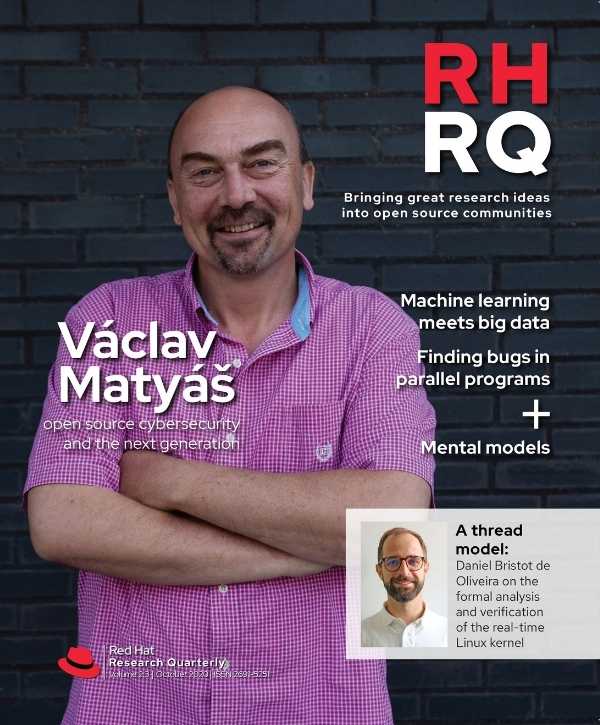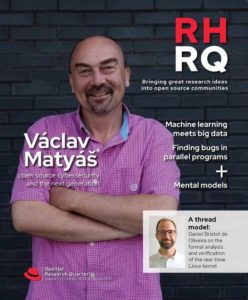Faculty, PhD students, and US Red Hat associates in Israel are collaborating actively on the following research projects. This quarter we highlight collaborative projects at Technion University, Tel Aviv University, and The Interdisciplinary Center Herzliya. We will highlight research collaborations from other parts of the world in future editions of the Research Quarterly. Contact academic@redhat.com for more information on any project described here.
PROJECT: OpenCEP: An Advanced Open Source Complex Event Processing Engine
Academic investigators: Prof. Assaf Schuster (Technion)
Red Hat investigators: Ilya Kolchinsky
In Red Hat Research Quarterly 2:1, investigators described their plan to build a scalable, real-time, cloud-based CEP engine capable of efficiently detecting arbitrarily complex patterns in high-volume data streams. The engine was designed to be implemented on top of Red Hat© OpenShift© Container Platform and to be applicable to any domain where event-based streaming data is present. Researchers aim to create an open source project/community based on the engine. They also hope to advance the state of the art in the area of complex event processing and combining academic research with the implementation and deployment of novel CEP mechanisms and techniques in the above framework.
Now the first version of the OpenCEP, an advanced open source complex event processing framework with cutting-edge pattern detection capabilities, is officially available for use. The next development iteration is underway and is expected to end in January.
PROJECT: Kubernetes Optimized Service Discovery Across Clusters
Academic investigators: Prof. Anat Bremler-Barr and Daniel Bachar, The Interdisciplinary Center Herzliya
Red Hat investigators: Mike Kolesnik
This research project aims to provide better and more balanced service discovery capabilities for Kubernetes multi-cluster deployments. Currently, the service discovery in this space is very basic. The project aims to investigate and assess different approaches for improving it by making it more balanced, reducing bottlenecks, and improving latency.
PROJECT: Electroencephalography (EEG) Feature Extraction
Academic investigators: Mrs. Lubov Blumkin, M.D. (Sackler School of Medicine, Tel Aviv University)
Red Hat investigators: Boris Odnopozov
This research is meant to improve the treatment of electrical status epilepticus (ESES). ESES is an age-related epileptic encephalopathy (EE) with very low incidence, typically in individuals between a few months of age and 12 years, peaking around ages 4-5.
In ESES, there is a disorder in the epileptiform activity in the brain that takes place during sleep, causing “unseen” (subclinical) seizures, although clinical seizures can also occur. While this condition tends to resolve with time, there can be sequelae in neuropsychological development (e.g., language capacity, intellectual level, memory, behavior) as well as motor impairment. Treatment is aimed at controlling both the seizures and their cause, the epileptiform activity.
One of the challenges physicians face when treating this disease is the difficulty of seeing if medication is working properly. Currently this requires monitoring a child during sleep using a full set of electrodes, which is both expensive and burdensome. As a result, physicians do not have enough feedback on the efficacy of the medication, which makes treatment less effective. Using Open Data Hub (opendatahub.io) for our calculations, we will attempt to see if we can detect ESES using only frontal electrodes. This allows a much easier, and more efficient home-based monitor that permits physicians to better administer medication and make treatment more effective.
For the past few months, we have researched the data for ESES detection with a reduced number of electrodes. We have added sleep-detection related features such as slow waves and spindles with the hope of differentiating sleep afflicted by ESES from normal sleep. We also added the use of UMAP to our pipeline for dimension reduction. These steps improved the precision of the classification.
We are faced with several challenges that we will take on in the coming months. First, the data we have is labeled at the recording resolution, i.e., each recording is either labeled as ESES or not. ESES by definition may only show on the EEG recording 80 percent of the time. Therefore we need a more granular labeling. To that end, we need to find a way to display the false positives and false negatives so that physicians can manually assess and classify the recordings. This is not as simple as one might think, since physicians are used to working with specific medical software that presents data in a very specific way. We need to improve the pipeline and engineer more features to improve detection, and we want to use the full power of working with hyper-parameterization that Open Data Hub offers.
PROJECT: Ceph: Wire-Level Compression-Efficient Object Storage Daemon Communication for the Cloud
Academic investigators: Prof. Anat Bremler-Barr and Maya Gilad, The Interdisciplinary Center Herzliya
Red Hat investigators: Josh Salomon
This project’s purpose is to reduce storage network traffic (object, block, etc.) for the following cases: between the failure domains in cost-sensitive environments such as public clouds, and between nodes in cases where the network bandwidth is the bottleneck of the node performance. We have divided the project into three milestones: applying compression for data transfer between different datacenters, enabling/disabling compression given hints from the client, and minimizing compression efforts when data is non-compressible.
Maya has completed the coding and basic testing of the on-wire compression for Ceph. It was presented in the IDC demo day for the course, and it was one of only two projects that created real production code (other projects were more research projects, mostly testing new AI/ML models). The PR is now in the review process by the upstream community, and it seems it will be approved soon, after some minor fixes. Initial results seem very promising, and a detailed report with the results will be published once the PR is approved.











